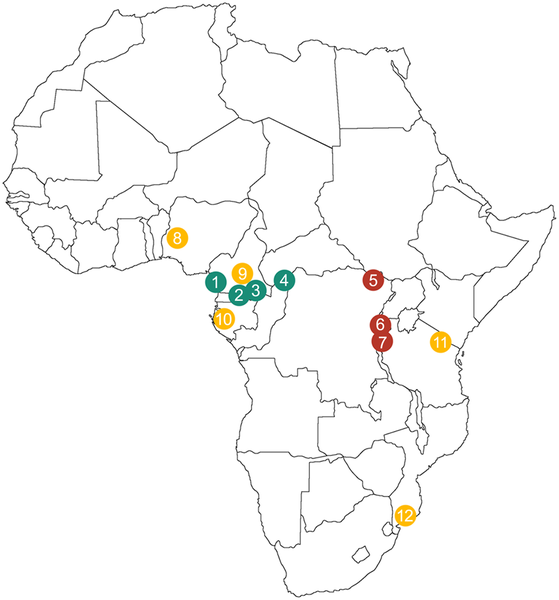All African Pygmies, inhabiting a large territory extending west-to-east along Central Africa, descend from a unique population who lived around 20,000 years ago, according to an international study led by researchers at the Institut Pasteur in Paris. The research concludes that the ancestors of present-day African Pygmies and neighboring farmers separated ~60,000 years ago.
Pygmies are characterized by a forest-dwelling hunter-gathering lifestyle and distinctive cultural practices and physical traits (e.g., low stature). Two groups of Pygmy populations live in the African rainforests: the "Western Pygmies" and the "Eastern Pygmies". The common origins of the two groups of Pygmies, separated by thousands of kilometers, have been long debated, and their relationships with neighboring farmers remained obscure.

Blue-green dots represent Western Pygmy (WPYG) populations, maroon dots represent Eastern Pygmy (EPYG) populations, and yellow dots represent agricultural (AGR) populations. 1. Bakola from Cameroon, 2. Baka from Gabon, 3. Baka from Cameroon, 4. Biaka from the Central Africa Republic, 5. Mbuti from the Democratic Republic of Congo, 6. Twa from northern Rwanda, 7. Twa from southern Rwanda, 8. Yoruba from Nigeria, 9. Ngumba from Cameroon, 10. Akele from Gabon, 11. Chagga from Tanzania, 12. Mozambicans from Mozambique. From Patin E, Laval G, Barreiro LB, Salas A, Semino O, et al. (2009) Inferring the Demographic History of African Farmers and Pygmy Hunter-Gatherers Using a Multilocus Resequencing Data Set. PLoS Genet 5(4): e1000448. doi:10.1371/journal.pgen.1000448
The researchers, led by Lluis Quintana-Murci, studied the genetic profile of twelve populations of Pygmies and neighboring farmers dispersed over the African continent, using sequence data from non-coding regions of their genomes. Using simulation-based procedures, they determined that the ancestors of Pygmy hunter-gatherers and farming populations started to diverge ~60,000 years ago, coinciding with a period of important human migration both within and outside Africa. Much later, ~20,000 years ago, Western and Eastern Pygmies separated, concurrently with a period of climate change leading to large retreats of the equatorial rainforest into refugia.
The common origin of all Pygmies unmasked in this study led Etienne Patin, one of the leading authors, to conclude that "they have probably inherited their distinctive shared physical traits, such as low height, from a common ancestor, rather than by convergent adaptation to the rainforest". However, complete genome-wide profiles of these populations are now needed, both to characterize more precisely their demographic history and to identify genes involved in the adaptation of these populations with different lifestyles to their specific ecological habitats.
CITATION: Patin E, Laval G, Barreiro LB, Salas A, Semino O, et al. (2009) Inferring the Demographic History of African Farmers and Pygmy Hunter-Gatherers Using a Multilocus Resequencing Data Set. PLoS Genet 5(4): e1000448. doi:10.1371/journal.pgen.1000448




Comments